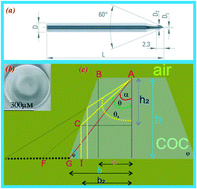Optimising the supercritical angle fluorescence structures in polymer microfluidic biochips for highly sensitive pathogen detection: a case study on Escherichia coli†
Abstract
In this paper, we present, to the best of our knowledge, for the first time, in-depth theoretical analysis and experimental results for the optimisation of supercritical angle fluorescence (SAF) structures in polymer microfluidic chips fabricated from a combination of micro-milling and polymer injection-moulding techniques for their application in the highly-sensitive detection of pathogens. In particular, we address experimentally and theoretically the relationship between the supercritical angle and the heights of the SAF structures embedded in the microfluidic chips to obtain optimised results where the highest fluorescence intensity is collected, and hence determining the optimised limit of detection (LOD). Together with theoretical modelling, we experimentally fabricate microarrays of SAF structures with different heights varying from zero to the order of 300 μm in cyclic olefin copolymer (COC) microfluidic chips. The results show that for fluorophores at the interface of air and COC, the highest fluorescence intensities are obtained at SAF structures with a 163 μm height for a milling tool with a 97.4 μm diameter, which is in excellent agreement with our modelling. A fluorescence LOD of 5.42 × 104 molecules is achieved when using such SAF structures. The solid-phase polymerase chain reaction (SP-PCR) on these SAF structures permits sensitive pathogen detection (3.37 × 102 copies of the E. coli genome per μL) on-chip. These results especially are of interest for applications in hypersensitive pathogen detection as well as in assisting the design of devices for point-of-care applications. Findings on the height optimization of SAF structures also advance our understanding of SAF detection techniques and provide insights into the development of fluorescence microscopy.



 Please wait while we load your content...
Please wait while we load your content...